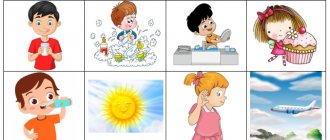Teaching children
Federal State Educational Standard
- Federal State Educational Standard for Preschool Education
- Preparation for school
- Fear of homework
- Problems at school for children
- The task of educators in preparing children for school
- Preparing for school in kindergarten
- Preparing for school in development centers
- What's happened ?
- What should a child be able to do for school?
- Preschool education
Children
- ABC and alphabet
- Alphabet for children
- ABC by syllables
- Russian alphabet for children
- Development of fine motor skills in children
- Introducing children to books
- Alphabet from diapers
- English for children
- Early development methods
- Sensory development of children
- The Maria Montessori method is best suited for this purpose.
- Physical development of children
- Preparation for school
- Preparing for school in the summer
- Children's imagination
- Development of attention in children
- Mindfulness exercises
- Development of attention in preschool children
- Games to develop children's thinking
- Games to develop logical thinking
- Development of logical thinking in children.
- Staging sounds
- Staging sound in
- Setting the sound r
- Hissing consonant sounds - production of sounds in preschool children
- Sound setting
- How to parse a word into sounds
- Syllables for preschool children
- Letter games for children
- Let's learn letters. A game.
- Children's literacy training
- Literacy lessons
- Literacy training - Harmony program
- Teaching Zhurova literacy
- Teaching literacy - Perspective methodology
- Literacy teaching UMK School of Russia
- Reading with characters
- Learning to read with Luntik
- Fixies teach you to read
We put the sounds [L], [L']
To set the sounds [L], [L'], use the exercises “Needle”, “Painter”, “Turkey Poults”, “Steps”, “Ladle”, “Hunter”.
If the sound [L] is absent in the child’s speech, it is placed in 2 stages:
- Interdental production of sound, when the child is asked to say the combination of sounds “ya”. When pronouncing the sound “y”, you need to pronounce it briefly, straining the articulatory apparatus. Next, pronunciation is carried out by squeezing the tongue between clenched teeth. Repeat the exercise until the clarity of the sound is established - you need to establish the position of the jaw in which it was possible to reproduce the sound.
- Dental production of sound - the tongue is moved to a position behind the teeth, it is pressed firmly to the alveoli, and they pronounce “ly-ly-ly.”
It is important to develop the correct direction of the air stream. If a child has several sounds in interdental pronunciation, it is worth developing motor skills of the tip of the tongue. You can help with this in any convenient mechanical way.
If a child replaces the sound [L] with the sound [Y], he is asked to place a round tube on the middle part of the side of the tongue, with his mouth open, and the tip of the tongue should be tucked behind the upper incisors. The main difficulty is that the child continues to hear the sound that he played earlier. Therefore, it is important to connect the baby’s auditory attention to the sound that he pronounces during its production.
Set the sound [C]
The articulation is as follows:
- lips are in a neutral position;
- teeth are brought closer by 1-2 mm;
- the tip of the tongue is lowered, touching the lower incisors; Initially, the back of the tongue is strongly curved, forming a bow with the incisors, then its front part quickly moves to the position of the “C” sound, forming a groove in the middle;
- the air stream should be strong and uneven.
The sound “C” is produced if the child clearly pronounces the sounds “S” and “T”. The baby is asked to quickly pronounce “TS”, as a result of which the desired sound appears.
There are 3 ways to make the sound “C”:
- Method of imitation using play techniques (“The locomotive, stopping, says - tss-ts-ts”, “The mouse is sleeping, don’t make noise - tss-ts-ts!”).
- Reception of reference sounds (in this case these are “T” and “S”).
- Acceptance of the features of articulatory structure. Invite the child to open his mouth, rest the tip of his tongue against the incisors of the lower row of teeth, lift the tongue and stretch it so that its front part is pressed against the palate. In this position, the back of the tongue should touch the upper incisors. Without turning on your voice, invite your baby to pronounce the sound “T”, lifting the tip of the tongue with the pressure of a stream of air from the front teeth of the lower row. The lips should be tense and in a smiling position. This exercise helps to remember the position of the organs of articulation when the sound “C” is pronounced.
Set the sound to [Z]
The articulation when producing the sound “Z” is similar to “S”, only the sound “Z” is more sonorous, so you need to use your voice when pronouncing it. The sound “Z” is placed after successful automation of “S”.
Setting “Z” is similar to working with the sound “S”, only you need to make sure that the child connects his voice and feels the vibration of the ligaments. It is very important to be able to convey to the child that these sounds differ in their sound. To do this, invite your baby to put his hand on his throat and pronounce both sounds alternately. The child will understand this difference by vibration. When the sound “Z” is heard clearly, invite the child to pronounce it louder and clearer. After this, automate the sound through exercises on pronouncing syllables, words, and sentences.
Sound setting [C]
The articulation of “C” is as follows:
- lips need to be stretched into a weak smile;
- bring your teeth closer, but do not close them;
- lean the tip of the tongue against the front teeth of the lower row, arch the tongue, resting its sides on the molars;
- create a strong and narrow air stream.
Before starting sound production, you should make sure that the child’s articulatory apparatus is ready to pronounce whistling sounds. For preparation, a set of special speech therapy exercises is used to improve the articulatory apparatus.
The sound “C” is placed in several ways:
- By imitation. Sitting with your child in front of the mirror, show how to pronounce the sound “C”.
- By imitation with game moments. For this method, visual aids and bright objects are used, with which you can imitate the sound “C”. For example, the balloon deflates - “SSSS”.
- Based on reference sounds. To learn to pronounce the sound “S”, a child must be able to pronounce the sounds “I” and “F”, which are the reference sounds for him.
- Mechanical setting. Using a spatula, the speech therapist sets the child’s tongue in the desired position and asks to gently but forcefully blow out the air.
The main thing is to give the child the opportunity to remember the position of the articulatory organs when playing the sound “C”, only then can it be automated in syllables, words and sentences.
We put the sounds [Ш], [Х], [Ч]
Setting the sound "SH"
To put the child’s articulatory organs in the correct position in which he can pronounce the sound “Sh”, you can use a mechanical technique. To do this, we ask the child to pronounce the long sound “C” or the syllable “SA”. At this time, you need to carefully lift the tip of the tongue by the upper row of teeth onto the alveoli using a spatula or spoon. Thanks to such manipulations, the child will be able to pronounce the sound “SH”. But it’s too early to end this exercise: it is important to draw the child’s attention to his pronunciation of this sound. The adult’s task is to help the baby understand and remember this position of the articulatory organs.
When the child manages to pronounce the sound “Ш”, its automation begins. To do this, they practice the sound, combining it with vowels: SHA-SHU-SHI-SHE-ASHA-ISHI-USHU-OSHO, etc. Then they practice the sound in words, first of all using those where the sound “SH” is at the beginning, and only then those in which he occupies a place in the middle or end.
Next, the sound is practiced in sentences. To do this, tongue twisters or quatrains can be used, most words of which contain the sound “Ш”. At the last stage of sound production, you can invite the child to independently compose a story using reference words.
To form the sound “Ш” the following techniques are used:
- Imitation performance. Ask your child to lift his tongue towards his upper lip, forcefully but evenly, and let him exhale, controlling the flow of air with the back of his hand. As soon as warm air is felt, offer to move the tongue behind the upper teeth, touching the palate. The mouth should be slightly open, the lips should be slightly extended, the teeth should be a couple of millimeters apart. Invite your baby to exhale a stream of air - you will get the sound “SH”.
- Setting the sound “T” to the base. Ask your baby to pronounce the sound “T” every 2 seconds. Then ask him to make his tongue hit the alveoli rather than the teeth. Gradually, the sonorous “T” will turn into a more hissing sound. Next, ask the child to round his lips and pull them forward, and lift his tongue up towards the palate (towards the front). The sides of the tongue should be pressed against the molars. Now, pronouncing the sound “T”, the child will be able to smoothly move on to pronouncing the sound “SH”.
- Based on the sound "S". Offer to move the tongue behind the lower teeth and pronounce the sound “C”. At the same time, use a spatula to lift the tongue up, let the child continue to pronounce the sound “C”. Using your fingers, lightly press on the cheeks so that the lips move forward. You should hear a hissing sound. To consolidate the result, ask your child to pronounce the syllables “SA”, “SI”, “SO”, “SY”, “SU”, “AS”, etc.
During classes, do not forget to use exercises that contribute to the general strengthening and development of the articulatory apparatus.
Making the sound “Zh”
The sound “Zh” is placed by analogy with the sound “Sh”. The only difference is that in this case we add voice sound. Articulation during production should be as follows:
- the lips are rounded and slightly moved forward;
- the teeth are close together, but not closed;
- the wide tip of the tongue is brought closer to the upper palate or alveoli, forming a gap between them; lower the middle of the tongue, pressing its edges to the side teeth; lift the back of the tongue and pull it back;
- a warm stream of air should pass through the middle of the tongue, which can be felt with the palm of your hand;
- the soft palate is lifted, pressing it to the pharynx, to its back wall, closing the passage into the nasopharynx, a stream of air exits through the mouth;
- The vocal folds need to be tensed and a voice must be produced.
As exercises, you can use imitation games (“Say what a bee says,” “...how a plane flies,” “...how a beetle buzzes,” etc.), tongue twisters, identifying sounds in words, and others.
Setting the sound "Ch"
When pronouncing the sound “Ch,” the child is asked to slightly round his lips, making a tube, and move them a little forward. There is no need to close your teeth, but they should be close to each other. The back and tip of the tongue should connect to the alveoli or upper teeth, forming a gap. When trying to pronounce the sound “Ch”, the child should feel a short stream of air passing through the middle of the tongue. The soft palate remains raised and pressed to the back of the pharynx. The vocal cords should not strain.
The sound “Ch” is made on the basis of “Ть” and “Ш”. Therefore, speech therapists use 2 methods of setting “H”:
- Ask your baby to pronounce the sound “TH” often and quickly (the tip of the tongue should touch the base of the upper teeth). Then the baby should gradually move his tongue back, touching the upper alveoli with it. In the process, the lips should stretch into a smile.
- Ask the child to first slowly and then quickly pronounce the sounds “TH” and “SH”, so that in the end it comes out TSH. Make sure that the child has a wide smile during the pronunciation process.
Automation of sound is performed in a playful way that is interesting for the child. Be sure to take into account the age of the baby when choosing activities and exercises. Don't neglect bright visual material.
Gymnastics for lips and tongue
In order for the child to easily master the desired position of the lips and tongue, you can do fun articulatory gymnastics with him for the sounds [v] and [f].
- "Snorting hedgehog." The baby imitates the snorting of a hedgehog. He will have to bring his lower lip closer to his upper teeth and exhale long. The result will be a sound [f] - perhaps not entirely clear, but this can be corrected with further exercises.
- "Breeze". We ask the little one to show how the breeze howls. First we show him ourselves. The breeze should be quiet at first, and then become louder, angrier. Often, children cannot purposefully “produce” a certain sound, but when they imitate someone or something, it comes out of their own accord.
- "Long Breeze" You can compete with the baby whose breeze will last the longest. At the same time, the duration of speech exhalation is also trained, which is important for the further development of speech skills, in particular the construction of long sentences.
During the exercises, show your child pictures, so it will be easier for him to tune in to the correct and effective completion of the task.
You can do such exercises while walking, imitating the breeze, imagining that a hedgehog is walking along the path nearby, or at home, listening to the wind outside the window or on an audio recording, writing a fairy tale about a brave hedgehog. Perhaps during such games the sound production will not be perfect, but this is the initial stage. Next, it will need to be sanded and secured.
We put the sounds [K], [G], [X]
The sound “K” is made mechanically using a spatula. The articulation looks like this:
- the lips should take the position of the next vowel sound;
- You can’t keep your teeth closed;
- the tip of the tongue needs to be lowered and touched with it to the incisors of the lower dentition;
- the lateral parts of the tongue are adjacent to the upper lateral teeth;
- the back of the tongue should form a bow with the palate;
- the soft palate rises at this time, blocking the passage to the nasopharynx;
- there is no need to strain the vocal cords, they are open;
- During exhalation, the resulting stream of air should explode the bow, causing a characteristic sound.
The first version of the production is from the sound “T”. It is used if the child pronounces the sound “T” clearly, cleanly, without unnecessary overtones.
Invite your baby to play the sound “TA”. At the same time, press the spatula on the front part of the back of the tongue, as a result of which the sound “TY” will be heard. Next, you need to move the spatula a little further into the depth, which will provoke the pronunciation of the sound “KY”. Even deeper pressure on the tongue gives a clear pronunciation of the sound “KA”. The use of the mechanical method is stopped when the child remembers the location of the articulatory organs for pronunciation of the sound being studied.
The sound “K” can be made while inhaling. This exercise is reminiscent of imitation snoring - silent or whispering. Encourage your child to snore for fun. After the exercise, you can hear a sound reminiscent of “K”. Invite your child to say “KA” while inhaling and exhaling. After this, automate the sound traditionally: “KA-KO-KU-KI-KE-KYO.”
The articulation of the sound “G” is similar to the articulation of the sound “K”. However, the voice is involved in this process - the vocal cords must close and vibrate during exercise.
The sound "G" can be placed from "Y". To do this, invite the child to throw his head back and, while exhaling strongly, say “YYYYY”, simultaneously pushing his lower jaw forward, raising it and lowering it. By analogy with the production of the sound “K” from “TA”, you can place the sound “G” from “DA”.
The articulation of the sound “X” differs from “K” in that the back of the back of the tongue should form not a bow with the palate, but a gap along the midline. The sound “X” can be made like this: invite the child to open his mouth the width of two fingers and blow warm air on his palms. If the sound does not work, you can try throwing your head up in the process. The sound “X” can be placed from “S” and “Sh”. They use a mechanical method: when the child pronounces these sounds, you need to use a spatula to move the tongue deeper into the mouth.
Set the sound [Y]
Most often, the sound “Y” can be produced by imitation, supplementing the exercises with showing correct articulation and the tactile sensation of the expiratory stream when pronouncing “YYYY” in a drawn-out manner.
They make a sound from pronouncing the sounds “AIA” or “IA”. The exhalation must be intensified when the sound “I” is pronounced, and the short “A” must be pronounced without interruption. Sometimes placing the “Y” sound in words where it comes first is effective.
From the syllable “ЗЯ” the sound is made mechanically: the child pronounces the syllable, and the adult, using a spatula, presses on the front part of the back of the tongue, gradually moving it back until the desired sound is obtained.









